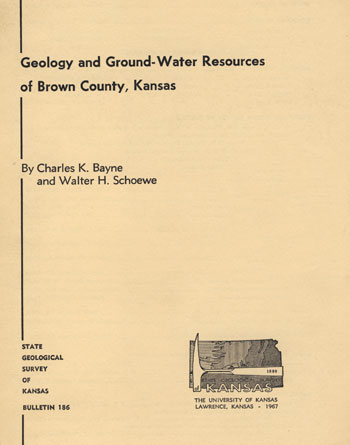Geology and Ground-water Resources of Brown County, Kansas
By Charles K. Bayne and Walter H. Schoewe

Originally published in 1967 as Kansas Geological Survey Bulletin 186. This is, in general, the original text as published. The information has not been updated. An Acrobat PDF version (11.3 MB) is also available; plates available separately.
You may also wish to visit our web site on the Brown County geologic map.
Abstract
Brown County is in the northern tier of counties in the State and is the second county west of the east border. It has an area of 576 square miles. It is in the Dissected Till Plains section of the Central Lowlands Province. The annual long-term mean precipitation is 34.20 inches, and the mean annual temperature is 53.3° F. Agriculture is the principal source of income in the county.
Rocks that underlie but do not crop out in the county range in age from Precambrian to Pennsylvanian (Virgilian). Rocks that crop out in the county range in age from Pennsylvanian to Permian. Cenozoic rocks consist of glacial till of Kansan age and loess of Wisconsinan and Illinoisan(?) ages. Fluvial deposits of Wisconsinan and Recent ages occur in the major valleys. The county lies in the Forest City Basin, which was a part of the North Kansas Basin prior to elevation of the Nemaha Anticline during Mississippian time.
Ground water is the principal source of water in the county; Horton is the only city that obtains its water supply from surface water. Glacial drift is the principal source of ground water in the area. Yields ranging up to 450 gpm (gallons per minute) are obtained from the glacial drift, but yields of less than 100 gpm are more common. Rocks of the Council Grove Group in northwestern Brown County yield as much as 250 gpm. Pennsylvanian sandstones in eastern Brown County yield small quantities of water. Generally less than 20 gpm of water are obtained from fluvial deposits in the major stream valleys.
Nearly all ground water in the area contains enough dissolved mineral matter to be considered hard. Chloride concentrations are not high at depths ordinarily reached by wells, but at greater depths they are present in high concentrations. Nitrate concentrations are higher in many wells than the recommended standards.
Kansas Geological Survey, Geology
Placed on web May 29, 2009; originally published May 1967.
Comments to webadmin@kgs.ku.edu
The URL for this page is http://www.kgs.ku.edu/General/Geology/Brown/index.html